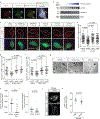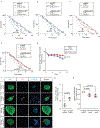Haploinsufficiency leads to neurodegeneration in C9ORF72 ALS/FTD human induced motor neurons
- PMID: 29400714
- PMCID: PMC6112156
- DOI: 10.1038/nm.4490
Haploinsufficiency leads to neurodegeneration in C9ORF72 ALS/FTD human induced motor neurons
Abstract
An intronic GGGGCC repeat expansion in C9ORF72 is the most common cause of amyotrophic lateral sclerosis (ALS) and frontotemporal dementia (FTD), but the pathogenic mechanism of this repeat remains unclear. Using human induced motor neurons (iMNs), we found that repeat-expanded C9ORF72 was haploinsufficient in ALS. We found that C9ORF72 interacted with endosomes and was required for normal vesicle trafficking and lysosomal biogenesis in motor neurons. Repeat expansion reduced C9ORF72 expression, triggering neurodegeneration through two mechanisms: accumulation of glutamate receptors, leading to excitotoxicity, and impaired clearance of neurotoxic dipeptide repeat proteins derived from the repeat expansion. Thus, cooperativity between gain- and loss-of-function mechanisms led to neurodegeneration. Restoring C9ORF72 levels or augmenting its function with constitutively active RAB5 or chemical modulators of RAB5 effectors rescued patient neuron survival and ameliorated neurodegenerative processes in both gain- and loss-of-function C9ORF72 mouse models. Thus, modulating vesicle trafficking was able to rescue neurodegeneration caused by the C9ORF72 repeat expansion. Coupled with rare mutations in ALS2, FIG4, CHMP2B, OPTN and SQSTM1, our results reveal mechanistic convergence on vesicle trafficking in ALS and FTD.
Conflict of interest statement
Competing financial interests
J.K.I. and P.A. are co-founders of Acurastem, Inc. P.A. is an employee of Icagen Corporation. J.K.I. and P.A. declare that they are bound by confidentiality agreements that prevent them from disclosing details of their financial interests in this work. S-J.L. is a founder of DRVision Technologies and T-Y.C. is an employee of DRVision Technologies. A.Z. and J.A.C. are co-founders of Verge Genomics and V.H-S., N.W., and T.G.B. are employees of Verge Genomics.
Figures






Comment in
-
Neurodegenerative disease: C9orf72 insufficiency cooperates with toxic repeat peptides to kill neurons.Nat Rev Neurol. 2018 Apr;14(4):196. doi: 10.1038/nrneurol.2018.22. Epub 2018 Feb 23. Nat Rev Neurol. 2018. PMID: 29472704 No abstract available.
-
A human cellular model of amyotrophic lateral sclerosis.Nat Med. 2018 Mar 6;24(3):256-257. doi: 10.1038/nm.4509. Nat Med. 2018. PMID: 29509753 No abstract available.
-
PIKFYVE Inhibition, A Neuronal "Emetic" for Treating ALS?Neurosci Bull. 2023 Nov;39(11):1738-1740. doi: 10.1007/s12264-023-01113-x. Epub 2023 Sep 9. Neurosci Bull. 2023. PMID: 37688660 Free PMC article. No abstract available.
References
Publication types
MeSH terms
Substances
Supplementary concepts
Grants and funding
- R37 NS034467/NS/NINDS NIH HHS/United States
- R01 AG023084/AG/NIA NIH HHS/United States
- R21 NS090912/NS/NINDS NIH HHS/United States
- R01 NS034467/NS/NINDS NIH HHS/United States
- R01 NS097850/NS/NINDS NIH HHS/United States
- K99 NS077435/NS/NINDS NIH HHS/United States
- R01 DC015530/DC/NIDCD NIH HHS/United States
- R00 NS077435/NS/NINDS NIH HHS/United States
- T32 DC009975/DC/NIDCD NIH HHS/United States
- P01 AG052350/AG/NIA NIH HHS/United States
- P50 AG005142/AG/NIA NIH HHS/United States
- R01 AG039452/AG/NIA NIH HHS/United States
- RF1 AG039452/AG/NIA NIH HHS/United States
- R37 AG023084/AG/NIA NIH HHS/United States
LinkOut - more resources
Full Text Sources
Other Literature Sources
Medical
Molecular Biology Databases
Research Materials
Miscellaneous

